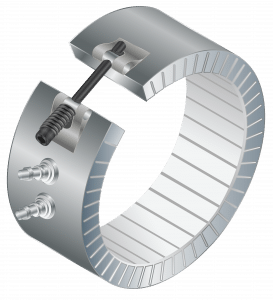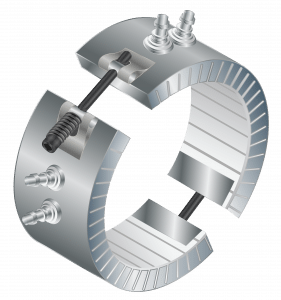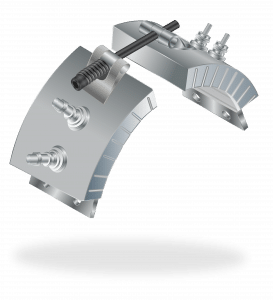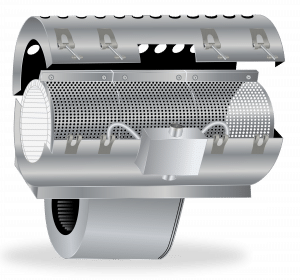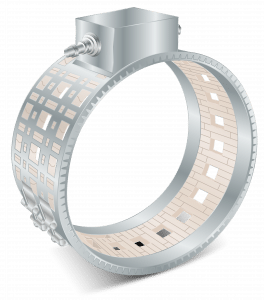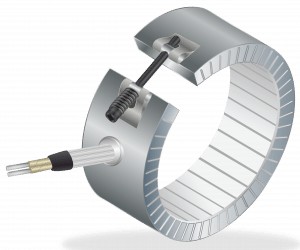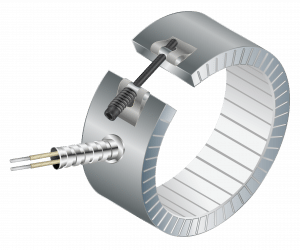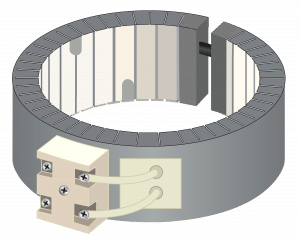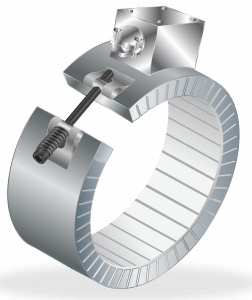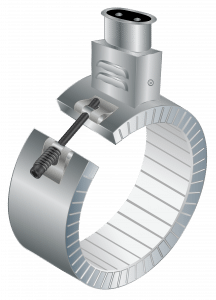Ceramic Band Heater Manufacturer


- Manufacturer
- Same Day Manufacturing Available
- CSAus Approved Heaters (UL Equivalent)
- Always On Time
- Fast, Cheap, and Reliable Shipping
- Quick Response Times (10 minutes or less)
Standard Lead Times
- 2 Weeks Manufacturing
- **Same Day Manufacturing Available**
- 1-3 days shipping
Ceramic band heaters are industrial heating elements that are designed with spirally wound inner resistance coils that are evenly threaded through interlocking insulated ceramic “tiles”. The ceramic core, or “mat” of tiles, is housed beneath a stainless steel sheet with serrated edges that fold over to secure the ends. A protective inner liner (to be removed at installation) is used to secure the placement of the tiles. This design offers a flexible heating system that is efficient in transmitting conduction and radiated heat.
The heat of the ceramic band originates from the inner coils that conduct heat at high temperatures. The heated coils evenly deliver heat through the ceramic tiles, which then radiate energy to the barrel. We offer a variety of ceramic band styles, from standard to custom configurations. When choosing a ceramic band heater, it’s important to select a heater that best matches the wattage requirements to decrease the frequency of cycling and temperature overshooting, and thus increase the life of the heater.
When installing a ceramic band heater to replace a non-insulated heater, it is recommended to decrease the total operating wattage by around 15-20 percent. If you don’t see a band heater style that meets your needs, please contact us at 416-675-7329 or email us at sales@mpimorheat.com,
Ceramic band heaters are commonly used in a variety of industrial applications such as extruders, injection molding machines, blown film dies, and other cylinder heating applications.
- Ceramic band heaters are designed with built-in insulation to minimize unwanted changes in temperature along the barrel.
- Heat transfer is efficient and occurs through radiation, conduction, and convection, allowing for a more flexible fit compared to other band heaters.
- Heat transfer is not impacted by irregular surfaces or a loose fit.
- Can be used in a wider range of applications because of the higher watt densities
- Simplified wiring which reduces the number of bands used.
- Cooler external surface, providing greater safety compared to other band heaters.
- Flexible design allows for easy installation and removal.
| Maximum Operating Temperature | 1600°F | |
| Maximum Voltage | 600 Volts | |
| Maximum Amps | 30 Amps | |
| Wattage Tolerance | +5%, -10% | |
| Maximum Recommended Watt Density | 55 W/in² | |
| Minimum Diameter | 1.5 inches | |
| Width Range | 0.8″-26″ (20mm-660mm) | |
| Heater Thickness | ||
| Heater Type | Nominal Thickness | Insulation Thickness |
| Standard | 5/8″ | 1/4″ |
| Extra Insulation | 15/16″ | 1/2″ |
| Insulation Option | Insulation Thickness / Band Thickness | Best for | Energy Savings |
| Standard | 1/4″ Insulation – 5/8″ Overall | Lower Temp / Lower Wattage Applications | Good |
| Extra Insulation | 1/2″ Insulation – 7/8″ Overall | Medium-High Temp / Medium-High Wattage Applications | Great |
| Insulation Max | 3/4″ Insulation – 1-1.25″ Overall | High Temp / High Watt Applications (up to 1600°F) | Excellent |
Always use utmost caution when handling any electrical components to prevent electric shock and injuries.
Read and understand the instructions before beginning installation.
Note that ceramic band heaters heat through radiation and conduction and do not require the same securing methods as other band heater designs.
- Remove the existing heater before installing the replacement.
- Do not install the heater in locations where gases or vapors are present.
- Ensure that adequate temperature controls are in place to prevent overheating and heater failure.
- Check that thermocouples, if present, are free of contaminants and have a good response to temperature changes to avoid overheating.
- Make sure all barrel surfaces are clean and free from contaminants to prevent electric shorts and heater failure.
- Remove the inner liner before installing the ceramic heater.
- Position the heater on the barrel and tighten the heater using the low thermal expansion outer housing until the serrated edges are securely in place. Avoid over-tightening to prevent the edges from collapsing or protruding outward.
- If the heater has screw terminals, remove the top nut and flat washers, but do not remove or loosen the bottom nut on the power screw terminals.
- Always have a qualified electrician handle the wiring of the ceramic band heater, using lead wire that is compatible with high temperatures and has the correct insulation and gauge size.
- To avoid short-circuiting, adjust the terminal lugs so that they face away from the heater case and from each other when connecting power leads.
- Verify that the voltage input to the heater does not exceed the heater’s voltage rating.
- Measure the amperage to confirm correct wiring (amps = Watts / Volts)
- Insulate and cover all live electrical connections for safety.
- Keep the installed heater away from any accumulating contaminants to prevent failure and prolong the life of the heater.


